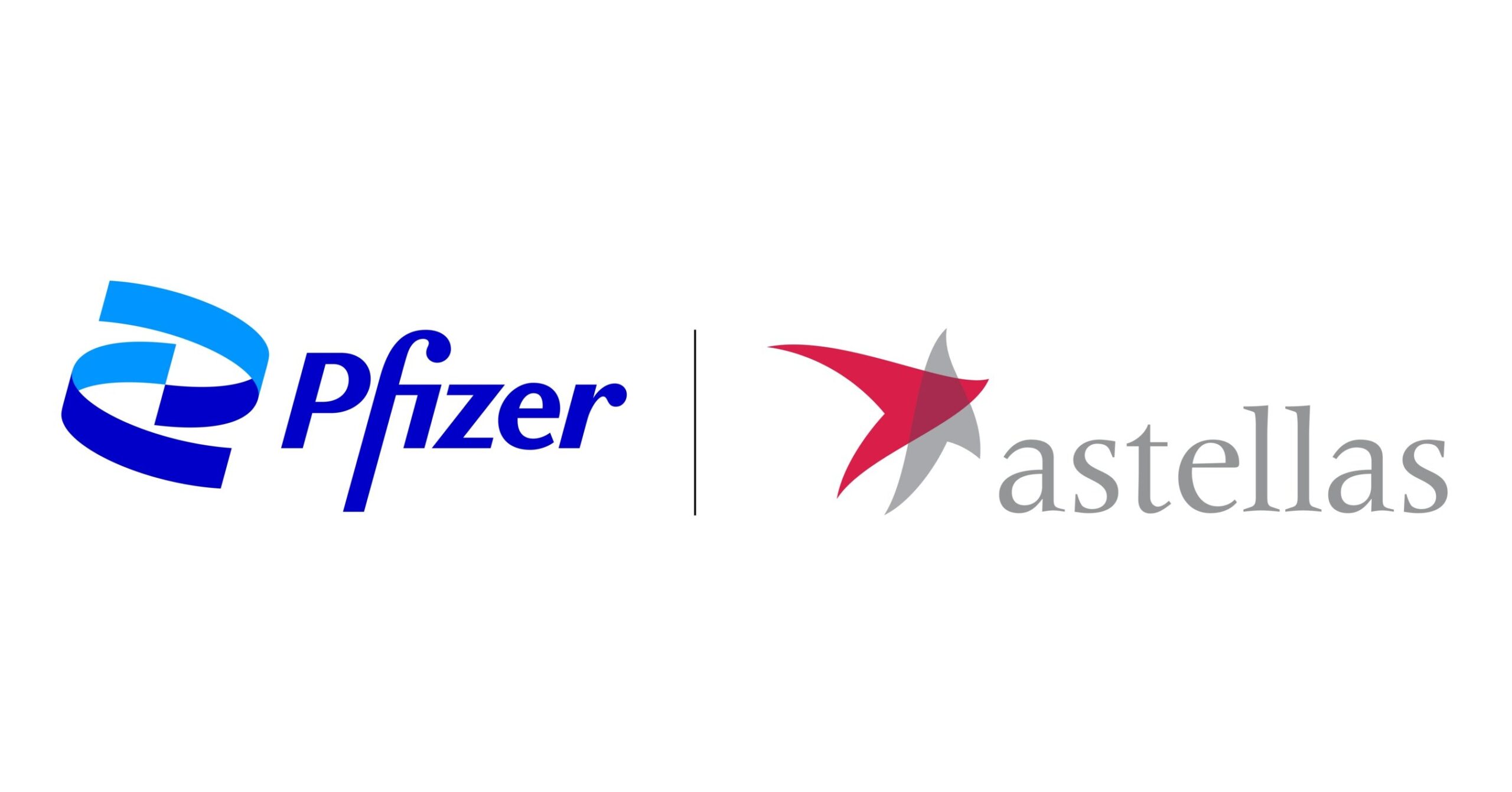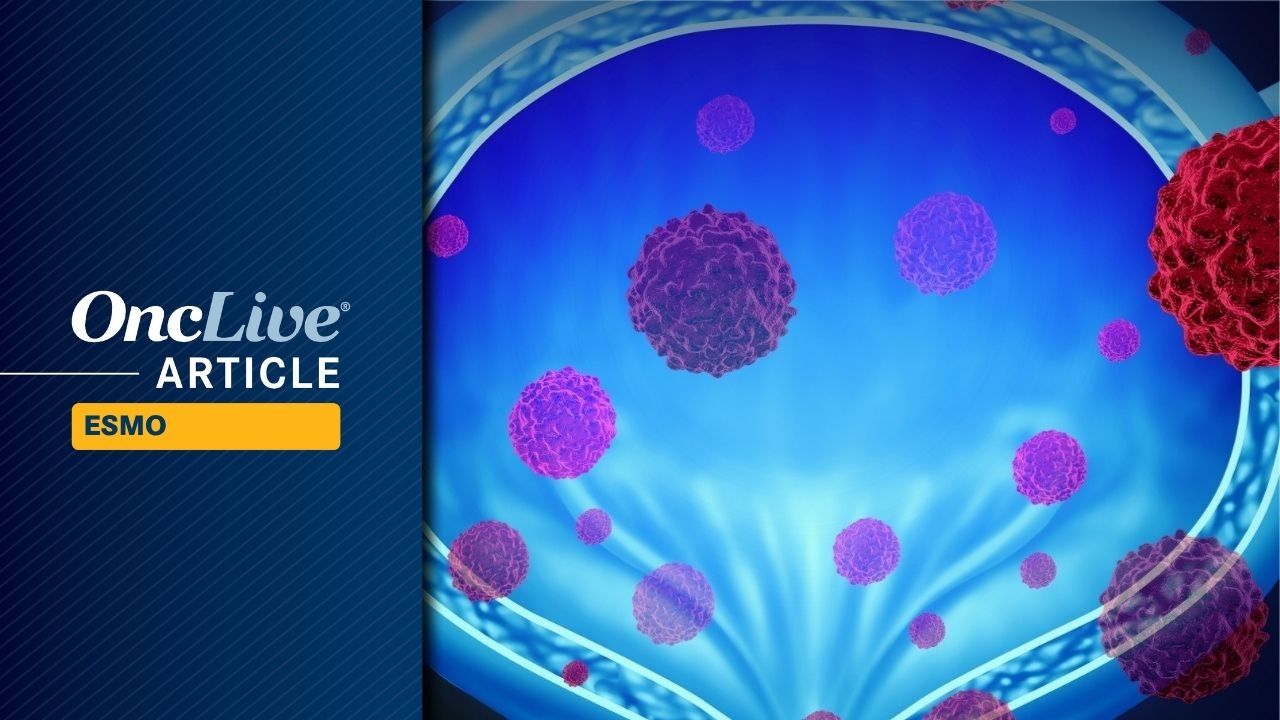Louis Tomlinson has opened up about the emotional aftermath of Liam Payne’s tragic untimely death.
Louis’ former One Direction bandmate died aged 31 in Buenos Aires…

Louis Tomlinson has opened up about the emotional aftermath of Liam Payne’s tragic untimely death.
Louis’ former One Direction bandmate died aged 31 in Buenos Aires…

TOKYO and NEW YORK, Oct. 18, 2025 /PRNewswire/ — Astellas Pharma Inc. (TSE: 4503, President and CEO: Naoki Okamura, “Astellas”) and Pfizer Inc. (NYSE: PFE) today announced positive results from the pivotal Phase 3 EV-303 clinical trial (also known as KEYNOTE-905) for PADCEV™ (enfortumab vedotin), a Nectin-4 directed antibody-drug conjugate, in combination with KEYTRUDA™ (pembrolizumab), a PD-1 inhibitor. The study evaluated the combination in patients with muscle-invasive bladder cancer (MIBC) who are ineligible for or declined cisplatin-based chemotherapy. PADCEV plus KEYTRUDA significantly improved event-free survival (EFS) and overall survival (OS) when used as a neoadjuvant and adjuvant treatment (before and after surgery) versus the current standard of care—surgery alone. Results from the EV-303 trial will be presented today in a Presidential Symposium (Abstract #LBA2) at the 2025 European Society of Medical Oncology (ESMO) Congress in Berlin, Germany.
At the first interim efficacy analysis, results from the primary endpoint of EFS showed a 60% reduction in the risk of tumor recurrence, progression or death for patients treated with neoadjuvant and adjuvant PADCEV plus KEYTRUDA as compared to surgery alone (Hazard Ratio (HR) of 0.40; 95% Confidence Interval (CI), 0.28-0.57; p<0.0001). The estimated median EFS has not yet been reached for the combination arm versus 15.7 months for the surgery alone arm. An estimated 74.7% of patients treated with the combination were event free at two years, relative to 39.4% of patients who received surgery only.
Results from the key secondary endpoint of OS showed a 50% reduction in the risk of death for neoadjuvant and adjuvant PADCEV plus KEYTRUDA as compared to surgery alone (HR of 0.50; 95% CI, 0.33-0.74; p<0.0002). The estimated median OS has not yet been reached for the combination arm versus 41.7 months for the surgery arm. An estimated 79.7% of patients were alive at two years relative to 63.1% of patients who received surgery only.
Consistent EFS and OS benefits were seen across all pre-defined subgroups, including age, gender, smoking status and PD-L1 status as well as protocol-defined stratification groups based on cisplatin ineligibility (ineligible vs eligible but declined), clinical stage and geographic region.
The safety results in EV-303 were consistent with those previously reported for this combination. The most common (≥30%) adverse events (AEs) reported in the neoadjuvant and adjuvant PADCEV plus KEYTRUDA arm were pruritus (itching), alopecia, diarrhea, fatigue and anemia. Grade ≥ 3 AEs due to any cause occurred in 71.3% of patients treated in the combination arm and 45.9% of patients who received surgery only.
Christof Vulsteke, M.D., Ph.D., Head of Integrated Cancer Center Ghent (IKG, Belgium) and Clinical Trial Unit Oncology Ghent and EV-303 Principal Investigator
“For decades, patients with muscle-invasive bladder cancer who are ineligible for cisplatin treatment have faced limited treatment options, often relying on surgery alone. The groundbreaking benefits seen in the KEYNOTE-905/EV-303 trial at this early interim analysis position the pembrolizumab and enfortumab vedotin combination to fundamentally change the way we approach the treatment of patients with this disease.”
For the secondary endpoint of pathologic complete response (pCR), treatment with neoadjuvant PADCEV plus KEYTRUDA demonstrated a 57.1% pCR rate versus an 8.6% pCR rate for patients who received surgery only (estimated difference 48.3%; 95% CI 39.5-56.5; p<0.000001).
Moitreyee Chatterjee-Kishore, Ph.D., M.B.A., Head of Oncology Development, Astellas
“The compelling EV-303 results may establish a new efficacy benchmark in muscle-invasive bladder cancer. For the first time, a systemic treatment approach used before and after surgery has improved survival over standard surgery in cisplatin-ineligible patients. These data underscore the transformative potential of PADCEV plus KEYTRUDA as we continue to explore this combination in a broad population of patients with muscle-invasive bladder cancer.”
Jeff Legos, Ph.D., M.B.A., Chief Oncology Officer, Pfizer
“The ability of PADCEV plus KEYTRUDA to reduce the risk of death by half in this setting is a remarkable advancement for patients who have seen limited treatment options and often face poor prognosis. These unprecedented results suggest that the transformational efficacy of this combination in advanced bladder cancer may extend into an earlier disease setting, potentially providing a life-changing impact for patients.”
Bladder cancer is the ninth most common cancer worldwide, diagnosed in more than 614,000 patients each year globally.1 MIBC represents approximately 30% of all bladder cancer cases.2 The standard treatment for patients with MIBC is neoadjuvant cisplatin-based chemotherapy followed by surgery, which has been shown to prolong survival.3 However, up to half of patients with MIBC are not eligible to receive cisplatin and face limited treatment options, typically undergoing surgery without any systemic treatment.3
PADCEV plus KEYTRUDA is not currently approved for use as neoadjuvant and adjuvant treatment in cisplatin-ineligible patients with MIBC. These results will be discussed with global health authorities for potential regulatory filings. Neoadjuvant and adjuvant PADCEV plus KEYTRUDA is also being evaluated in cisplatin-eligible patients with MIBC in the EV-304 Phase 3 clinical trial (also known as KEYNOTE-B15).
The EV-303 trial is continuing to evaluate the secondary EFS, OS and pCR rate endpoints for neoadjuvant and adjuvant KEYTRUDA monotherapy versus surgery alone as they continue to mature.
About the EV-303/KEYNOTE-905 Trial
The EV-303 trial (also known as KEYNOTE-905) is an ongoing, open-label, randomized, three-arm, controlled, Phase 3 study evaluating neoadjuvant and adjuvant PADCEV plus KEYTRUDA or neoadjuvant and adjuvant KEYTRUDA versus surgery alone in patients with MIBC who are either not eligible for or declined cisplatin-based chemotherapy. Patients were randomized to receive either neoadjuvant and adjuvant KEYTRUDA (arm A), surgery alone (arm B) or neoadjuvant and adjuvant PADCEV plus KEYTRUDA (arm C).4
The primary endpoint of this trial is EFS between arm C and arm B, defined as the time from randomization to the first occurrence of any of the following events: progression of disease that precludes radical cystectomy (RC) surgery or failure to undergo RC surgery in participants with residual disease, gross residual disease left behind at the time of surgery, local or distant recurrence as assessed by imaging and/or biopsy or death due to any cause. Key secondary endpoints include OS and pCR rate between arm C and arm B, as well as EFS, OS and pCR rate between arm A and arm B.4
For more information on the global EV-303 trial, go to clinicaltrials.gov.
About PADCEV™ (enfortumab vedotin)
PADCEV™ (enfortumab vedotin) is a first-in-class antibody-drug conjugate (ADC) that is directed against Nectin-4, a protein located on the surface of cells and highly expressed in bladder cancer.5 Nonclinical data suggest the anticancer activity of PADCEV is due to its binding to Nectin-4-expressing cells, followed by the internalization and release of the anti-tumor agent monomethyl auristatin E (MMAE) into the cell, which result in the cell not reproducing (cell cycle arrest) and in programmed cell death (apoptosis).6
PADCEV plus KEYTRUDA is approved for the treatment of adult patients with locally advanced or metastatic urothelial cancer (la/mUC) regardless of cisplatin eligibility in the United States, Japan, and a number of other countries around the world. In the European Union, the combination is approved for the treatment of adult patients with la/mUC who are eligible for platinum-containing chemotherapy. PADCEV is also approved as a single agent for the treatment of adult patients with la/mUC who have previously received a PD-1/PD-L1 inhibitor and platinum-containing chemotherapy or are ineligible for cisplatin-containing chemotherapy and have previously received one or more prior lines of therapy.6
PADCEV® (enfortumab vedotin-ejfv) U.S. Indication & Important Safety Information
BOXED WARNING: SERIOUS SKIN REACTIONS
Indication
PADCEV®, in combination with pembrolizumab, is indicated for the treatment of adult patients with locally advanced or metastatic urothelial cancer (mUC).
PADCEV, as a single agent, is indicated for the treatment of adult patients with locally advanced or mUC who:
PADCEV Important Safety Information
Warnings and Precautions
Skin reactions Severe cutaneous adverse reactions, including fatal cases of SJS or TEN occurred in patients treated with PADCEV. SJS and TEN occurred predominantly during the first cycle of treatment but may occur later. Skin reactions occurred in 70% (all grades) of the 564 patients treated with PADCEV in combination with pembrolizumab in clinical trials. When PADCEV was given in combination with pembrolizumab, the incidence of skin reactions, including severe events, occurred at a higher rate compared to PADCEV as a single agent. The majority of the skin reactions that occurred with combination therapy included maculo-papular rash, macular rash and papular rash. Grade 3-4 skin reactions occurred in 17% of patients (Grade 3: 16%, Grade 4: 1%), including maculo-papular rash, bullous dermatitis, dermatitis, exfoliative dermatitis, pemphigoid, rash, erythematous rash, macular rash, and papular rash. A fatal reaction of bullous dermatitis occurred in one patient (0.2%). The median time to onset of severe skin reactions was 1.7 months (range: 0.1 to 17.2 months). Skin reactions led to discontinuation of PADCEV in 6% of patients.
Skin reactions occurred in 58% (all grades) of the 720 patients treated with PADCEV as a single agent in clinical trials. Twenty-three percent (23%) of patients had maculo-papular rash and 34% had pruritus. Grade 3-4 skin reactions occurred in 14% of patients, including maculo-papular rash, erythematous rash, rash or drug eruption, symmetrical drug-related intertriginous and flexural exanthema (SDRIFE), bullous dermatitis, exfoliative dermatitis, and palmar-plantar erythrodysesthesia. The median time to onset of severe skin reactions was 0.6 months (range: 0.1 to 8 months). Among patients experiencing a skin reaction leading to dose interruption who then restarted PADCEV (n=75), 24% of patients restarting at the same dose and 24% of patients restarting at a reduced dose experienced recurrent severe skin reactions. Skin reactions led to discontinuation of PADCEV in 3.1% of patients.
Monitor patients closely throughout treatment for skin reactions. Consider topical corticosteroids and antihistamines, as clinically indicated. For persistent or recurrent Grade 2 skin reactions, consider withholding PADCEV until Grade ≤1. Withhold PADCEV and refer for specialized care for suspected SJS, TEN or for Grade 3 skin reactions. Permanently discontinue PADCEV in patients with confirmed SJS or TEN; or Grade 4 or recurrent Grade 3 skin reactions.
Hyperglycemia and diabetic ketoacidosis (DKA), including fatal events, occurred in patients with and without pre-existing diabetes mellitus, treated with PADCEV. Patients with baseline hemoglobin A1C ≥8% were excluded from clinical trials. In clinical trials of PADCEV as a single agent, 17% of the 720 patients treated with PADCEV developed hyperglycemia of any grade; 7% of patients developed Grade 3-4 hyperglycemia (Grade 3: 6.5%, Grade 4: 0.6%). Fatal events of hyperglycemia and DKA occurred in one patient each (0.1%). The incidence of Grade 3-4 hyperglycemia increased consistently in patients with higher body mass index and in patients with higher baseline A1C. The median time to onset of hyperglycemia was 0.5 months (range: 0 to 20 months). Hyperglycemia led to discontinuation of PADCEV in 0.7% of patients. Five percent (5%) of patients required initiation of insulin therapy for treatment of hyperglycemia. Of the patients who initiated insulin therapy for treatment of hyperglycemia, 66% (23/35) discontinued insulin at the time of last evaluation. Closely monitor blood glucose levels in patients with, or at risk for, diabetes mellitus or hyperglycemia. If blood glucose is elevated (>250 mg/dL), withhold PADCEV.
Pneumonitis/Interstitial Lung Disease (ILD) Severe, life-threatening or fatal pneumonitis/ILD occurred in patients treated with PADCEV. When PADCEV was given in combination with pembrolizumab, 10% of the 564 patients treated with combination therapy had pneumonitis/ILD of any grade and 4% had Grade 3-4. A fatal event of pneumonitis/ILD occurred in two patients (0.4%). The incidence of pneumonitis/ILD, including severe events, occurred at a higher rate when PADCEV was given in combination with pembrolizumab compared to PADCEV as a single agent. The median time to onset of any grade pneumonitis/ILD was 4 months (range: 0.3 to 26 months).
In clinical trials of PADCEV as a single agent, 3% of the 720 patients treated with PADCEV had pneumonitis/ILD of any grade and 0.8% had Grade 3-4. The median time to onset of any grade pneumonitis/ILD was 2.9 months (range: 0.6 to 6 months).
Monitor patients for signs and symptoms indicative of pneumonitis/ILD such as hypoxia, cough, dyspnea or interstitial infiltrates on radiologic exams. Evaluate and exclude infectious, neoplastic and other causes for such signs and symptoms through appropriate investigations. Withhold PADCEV for patients who develop Grade 2 pneumonitis/ILD and consider dose reduction. Permanently discontinue PADCEV in all patients with Grade 3 or 4 pneumonitis/ILD.
Peripheral neuropathy (PN) When PADCEV was given in combination with pembrolizumab, 67% of the 564 patients treated with combination therapy had PN of any grade, 36% had Grade 2 neuropathy, and 7% had Grade 3 neuropathy. The incidence of PN occurred at a higher rate when PADCEV was given in combination with pembrolizumab compared to PADCEV as a single agent. The median time to onset of Grade ≥2 PN was 6 months (range: 0.3 to 25 months).
PN occurred in 53% of the 720 patients treated with PADCEV as a single agent in clinical trials including 38% with sensory neuropathy, 8% with muscular weakness and 7% with motor neuropathy. Thirty percent of patients experienced Grade 2 reactions and 5% experienced Grade 3-4 reactions. PN occurred in patients treated with PADCEV with or without preexisting PN. The median time to onset of Grade ≥2 PN was 4.9 months (range: 0.1 to 20 months). Neuropathy led to treatment discontinuation in 6% of patients.
Monitor patients for symptoms of new or worsening PN and consider dose interruption or dose reduction of PADCEV when PN occurs. Permanently discontinue PADCEV in patients who develop Grade ≥3 PN.
Ocular disorders were reported in 40% of the 384 patients treated with PADCEV as a single agent in clinical trials in which ophthalmologic exams were scheduled. The majority of these events involved the cornea and included events associated with dry eye such as keratitis, blurred vision, increased lacrimation, conjunctivitis, limbal stem cell deficiency, and keratopathy. Dry eye symptoms occurred in 30% of patients, and blurred vision occurred in 10% of patients, during treatment with PADCEV. The median time to onset to symptomatic ocular disorder was 1.7 months (range: 0 to 30.6 months). Monitor patients for ocular disorders. Consider artificial tears for prophylaxis of dry eyes and ophthalmologic evaluation if ocular symptoms occur or do not resolve. Consider treatment with ophthalmic topical steroids, if indicated after an ophthalmic exam. Consider dose interruption or dose reduction of PADCEV for symptomatic ocular disorders.
Infusion site extravasation Skin and soft tissue reactions secondary to extravasation have been observed after administration of PADCEV. Of the 720 patients treated with PADCEV as a single agent in clinical trials, 1% of patients experienced skin and soft tissue reactions, including 0.3% who experienced Grade 3-4 reactions. Reactions may be delayed. Erythema, swelling, increased temperature, and pain worsened until 2-7 days after extravasation and resolved within 1-4 weeks of peak. Two patients (0.3%) developed extravasation reactions with secondary cellulitis, bullae, or exfoliation. Ensure adequate venous access prior to starting PADCEV and monitor for possible extravasation during administration. If extravasation occurs, stop the infusion and monitor for adverse reactions.
Embryo-fetal toxicity PADCEV can cause fetal harm when administered to a pregnant woman. Advise patients of the potential risk to the fetus. Advise female patients of reproductive potential to use effective contraception during PADCEV treatment and for 2 months after the last dose. Advise male patients with female partners of reproductive potential to use effective contraception during treatment with PADCEV and for 4 months after the last dose.
ADVERSE REACTIONS
Most common adverse reactions, including laboratory abnormalities (≥20%) (PADCEV in combination with pembrolizumab)
Increased aspartate aminotransferase (AST), increased creatinine, rash, increased glucose, PN, increased lipase, decreased lymphocytes, increased alanine aminotransferase (ALT), decreased hemoglobin, fatigue, decreased sodium, decreased phosphate, decreased albumin, pruritus, diarrhea, alopecia, decreased weight, decreased appetite, increased urate, decreased neutrophils, decreased potassium, dry eye, nausea, constipation, increased potassium, dysgeusia, urinary tract infection and decreased platelets.
Most common adverse reactions, including laboratory abnormalities (≥20%) (PADCEV monotherapy)
Increased glucose, increased AST, decreased lymphocytes, increased creatinine, rash, fatigue, PN, decreased albumin, decreased hemoglobin, alopecia, decreased appetite, decreased neutrophils, decreased sodium, increased ALT, decreased phosphate, diarrhea, nausea, pruritus, increased urate, dry eye, dysgeusia, constipation, increased lipase, decreased weight, decreased platelets, abdominal pain, dry skin.
EV-302 Study: 440 patients with previously untreated la/mUC (PADCEV in combination with pembrolizumab)
Serious adverse reactions occurred in 50% of patients treated with PADCEV in combination with pembrolizumab. The most common serious adverse reactions (≥2%) were rash (6%), acute kidney injury (5%), pneumonitis/ILD (4.5%), urinary tract infection (3.6%), diarrhea (3.2%), pneumonia (2.3%), pyrexia (2%), and hyperglycemia (2%). Fatal adverse reactions occurred in 3.9% of patients treated with PADCEV in combination with pembrolizumab including acute respiratory failure (0.7%), pneumonia (0.5%), and pneumonitis/ILD (0.2%).
Adverse reactions leading to discontinuation of PADCEV occurred in 35% of patients. The most common adverse reactions (≥2%) leading to discontinuation of PADCEV were PN (15%), rash (4.1%) and pneumonitis/ILD (2.3%). Adverse reactions leading to dose interruption of PADCEV occurred in 73% of patients. The most common adverse reactions (≥2%) leading to dose interruption of PADCEV were PN (22%), rash (16%), COVID19 (10%), diarrhea (5%), pneumonitis/ILD (4.8%), fatigue (3.9%), hyperglycemia (3.6%), increased ALT (3%) and pruritus (2.5%). Adverse reactions leading to dose reduction of PADCEV occurred in 42% of patients. The most common adverse reactions (≥2%) leading to dose reduction of PADCEV were rash (16%), PN (13%) and fatigue (2.7%).
EV-103 Study: 121 patients with previously untreated la/mUC who were not eligible for cisplatin-containing chemotherapy (PADCEV in combination with pembrolizumab)
Serious adverse reactions occurred in 50% of patients treated with PADCEV in combination with pembrolizumab; the most common (≥2%) were acute kidney injury (7%), urinary tract infection (7%), urosepsis (5%), sepsis (3.3%), pneumonia (3.3%), hematuria (3.3%), pneumonitis/ILD (3.3%), urinary retention (2.5%), diarrhea (2.5%), myasthenia gravis (2.5%), myositis (2.5%), anemia (2.5%), and hypotension (2.5%). Fatal adverse reactions occurred in 5% of patients treated with PADCEV in combination with pembrolizumab, including sepsis (1.6%), bullous dermatitis (0.8%), myasthenia gravis (0.8%), and pneumonitis/ILD (0.8%). Adverse reactions leading to discontinuation of PADCEV occurred in 36% of patients; the most common (≥2%) were PN (20%) and rash (6%). Adverse reactions leading to dose interruption of PADCEV occurred in 69% of patients; the most common (≥2%) were PN (18%), rash (12%), increased lipase (6%), pneumonitis/ILD (6%), diarrhea (4.1%), acute kidney injury (3.3%), increased ALT (3.3%), fatigue (3.3%), neutropenia (3.3%), urinary tract infection (3.3%), increased amylase (2.5%), anemia (2.5%), COVID19 (2.5%), hyperglycemia (2.5%), and hypotension (2.5%). Adverse reactions leading to dose reduction of PADCEV occurred in 45% of patients; the most common (≥2%) were PN (17%), rash (12%), fatigue (5%), neutropenia (5%), and diarrhea (4.1%).
EV-301 Study: 296 patients previously treated with a PD-1/L1 inhibitor and platinum-based chemotherapy (PADCEV monotherapy)
Serious adverse reactions occurred in 47% of patients treated with PADCEV; the most common (≥2%) were urinary tract infection, acute kidney injury (7% each), and pneumonia (5%). Fatal adverse reactions occurred in 3% of patients, including multiorgan dysfunction (1%), hepatic dysfunction, septic shock, hyperglycemia, pneumonitis/ILD, and pelvic abscess (0.3% each). Adverse reactions leading to discontinuation occurred in 17% of patients; the most common (≥2%) were PN (5%) and rash (4%). Adverse reactions leading to dose interruption occurred in 61% of patients; the most common (≥4%) were PN (23%), rash (11%), and fatigue (9%). Adverse reactions leading to dose reduction occurred in 34% of patients; the most common (≥2%) were PN (10%), rash (8%), decreased appetite, and fatigue (3% each).
EV-201, Cohort 2 Study: 89 patients previously treated with a PD-1/L1 inhibitor and not eligible for cisplatin-based chemotherapy (PADCEV monotherapy)
Serious adverse reactions occurred in 39% of patients treated with PADCEV; the most common (≥3%) were pneumonia, sepsis, and diarrhea (5% each). Fatal adverse reactions occurred in 8% of patients, including acute kidney injury (2.2%), metabolic acidosis, sepsis, multiorgan dysfunction, pneumonia, and pneumonitis/ILD (1.1% each). Adverse reactions leading to discontinuation occurred in 20% of patients; the most common (≥2%) was PN (7%). Adverse reactions leading to dose interruption occurred in 60% of patients; the most common (≥3%) were PN (19%), rash (9%), fatigue (8%), diarrhea (5%), increased AST, and hyperglycemia (3% each). Adverse reactions leading to dose reduction occurred in 49% of patients; the most common (≥3%) were PN (19%), rash (11%), and fatigue (7%).
DRUG INTERACTIONS
Effects of other drugs on PADCEV (Dual P-gp and Strong CYP3A4 Inhibitors)
Concomitant use with dual P-gp and strong CYP3A4 inhibitors may increase unconjugated monomethyl auristatin E exposure, which may increase the incidence or severity of PADCEV toxicities. Closely monitor patients for signs of toxicity when PADCEV is given concomitantly with dual P-gp and strong CYP3A4 inhibitors.
SPECIFIC POPULATIONS
Lactation Advise lactating women not to breastfeed during treatment with PADCEV and for 3 weeks after the last dose.
Hepatic impairment Avoid the use of PADCEV in patients with moderate or severe hepatic impairment.
For more information, please see the U.S. full Prescribing Information including BOXED WARNING for PADCEV here .
About Astellas
Astellas is a global life sciences company committed to turning innovative science into VALUE for patients. We provide transformative therapies in disease areas that include oncology, ophthalmology, urology, immunology and women’s health. Through our research and development programs, we are pioneering new healthcare solutions for diseases with high unmet medical need. Learn more at www.astellas.com.
About Pfizer Oncology
At Pfizer Oncology, we are at the forefront of a new era in cancer care. Our industry-leading portfolio and extensive pipeline includes three core mechanisms of action to attack cancer from multiple angles, including small molecules, antibody-drug conjugates (ADCs), and multispecific antibodies, including other immune-oncology biologics. We are focused on delivering transformative therapies in some of the world’s most common cancers, including breast cancer, genitourinary cancer, hematology-oncology, and thoracic cancers, which includes lung cancer. Driven by science, we are committed to accelerating breakthroughs to help people with cancer live better and longer lives.
About the Pfizer, Astellas and Merck Collaboration
Seagen and Astellas previously entered a clinical collaboration agreement with Merck to evaluate the combination of Seagen’s and Astellas’ PADCEV™ (enfortumab vedotin) and Merck’s KEYTRUDA™ (pembrolizumab) in patients with muscle-invasive bladder cancer (MIBC) who are not eligible for or declined cisplatin-based chemotherapy. Pfizer Inc. successfully completed its acquisition of Seagen on December 14, 2023. KEYTRUDA is a registered trademark of Merck Sharp & Dohme Corp., a subsidiary of Merck & Co., Inc., Rahway, NJ, USA (known as MSD outside of the United States and Canada).
Astellas Cautionary Notes
In this press release, statements made with respect to current plans, estimates, strategies and beliefs and other statements that are not historical facts are forward-looking statements about the future performance of Astellas. These statements are based on management’s current assumptions and beliefs in light of the information currently available to it and involve known and unknown risks and uncertainties. A number of factors could cause actual results to differ materially from those discussed in the forward-looking statements. Such factors include, but are not limited to: (i) changes in general economic conditions and in laws and regulations, relating to pharmaceutical markets, (ii) currency exchange rate fluctuations, (iii) delays in new product launches, (iv) the inability of Astellas to market existing and new products effectively, (v) the inability of Astellas to continue to effectively research and develop products accepted by customers in highly competitive markets, and (vi) infringements of Astellas’ intellectual property rights by third parties. Information about pharmaceutical products (including products currently in development) which is included in this press release is not intended to constitute an advertisement or medical advice.
Pfizer Disclosure Notice
The information contained in this release is as of October 18, 2025. Pfizer assumes no obligation to update forward-looking statements contained in this release as the result of new information or fu ture events or developments.
This release contains forward-looking information about Pfizer Oncology and PADCEV™ (enfortumab vedotin) in combination with pembrolizumab in cisplatin-ineligible patients with muscle-invasive bladder cancer, including their potential benefits and plans to present the Phase 3 EV-303 clinical trial results at the 2025 European Society of Medical Oncology Congress and discuss the Phase 3 EV-303 clinical trial results with global health authorities for potential regulatory filings that involves substantial risks and uncertainties that could cause actual results to differ materially from those expressed or implied by such statements. Risk and uncertainties include, among other things, uncertainties regarding the commercial success of enfortumab vedotin; the uncertainties inherent in research and development, including the a bility to meet anticipated clinical endpoints (and continuing evaluation of endpoints), commencement and/or completion dates for our clinical trials, regulatory submission dates, regulatory approval dates and/or launch dates, as well as the possibility of unfavorable new clinical data and further analyses of existing clinical data; risks associated with interim data; the risk that clinical trial data are subject to differing interpretations and assessments by regulatory autho rities; whether regulatory authorities will be satisfied with the design of and results from our clinical studies; whether and when any applications may be filed with regulatory authorities in particular jurisdictions for any potential indication for enfortumab vedotin with pembrolizumab or as a single agent ; whether and when any applications that may be pending or filed for enfortumab vedotin with pembrolizumab or as a single agent may be approved by regulatory authorities, which will depend on myriad factors, inclu ding making a determination as to whether the product’s benefits outweigh its known risks and determination of the product’s efficacy and, if approved, whether enfortumab vedotin with pembrolizumab or as a single agent will be commercially successful; decisions by regulatory authorities impacting labeling, manufacturing processes, safety and/or other matters that could affect the availability or commercial potential of enfortumab vedotin with pembrolizumab or as a single agent; whether the collaboration between Pfizer, Astellas and Merck will be successful; risks and uncertainties related to issued or future executive orders or other new, or changes in, laws or regulations; uncertainties regarding the impact of COVID-19 on Pfizer’s business, operations and financial results; and competitive developments.
A further description of risks and uncertainties can be found in Pfizer’s Annual Report on Form 10-K for the fiscal year ended December 31, 2024, and in its subsequent reports on Form 10-Q, including in the sections thereof captioned “Risk Factors” and “Forward-Looking Information and Factors That May Affect Future Results”, as well as in its subsequent reports on Form 8-K, all of which are filed with the U.S. Securities and Exchange Commission and available at www.sec.gov and www.pfizer.com .
|
1 World Bladder Cancer Patient Coalition. GLOBOCAN 2022: Bladder cancer 9th most common worldwide. Accessed October 16, 2025. Available at: https://worldbladdercancer.org/news_events/globocan-2022-bladder-cancer-is-the-9th-most-commonly-diagnosed-worldwide/ |
|
2 Bladder Cancer Awareness Network. What is Muscle Invasive Bladder Cancer? Accessed October 16, 2025. Available at: https://bcan.org/what-is-muscle-invasive-bladder-cancer/#:~:text=When%20tumors%20grow%20into%20or,Virginia%20Health%20System%20explain%20MIBC. |
|
3 Esteban-Villarrubia J, Torres-Jiménez J, Bueno-Bravo C, García-Mondaray R, Subiela JD, Gajate P. Current and Future Landscape of Perioperative Treatment for Muscle-Invasive Bladder Cancer. Cancers (Basel). 2023 Jan 17;15(3):566. doi: 10.3390/cancers15030566. PMID: 36765525; PMCID: PMC9913718. |
|
4 National Institute of Health. National Library of Medicine. Perioperative Pembrolizumab (MK-3475) Plus Cystectomy or Perioperative Pembrolizumab Plus Enfortumab Vedotin Plus Cystectomy Versus Cystectomy Alone in Participants Who Are Cisplatin-ineligible or Decline Cisplatin With Muscle-invasive Bladder Cancer (MK-3475-905/KEYNOTE-905/EV-303. ClinicalTrials.gov identifier: NCT03924895. Published July 24, 2019. Updated June 17, 2025. Accessed October 16, 2025. Available at: https://clinicaltrials.gov/study/NCT03924895?term=AREA%5BBasicSearch%5D(myosarcoma)&rank=3 |
|
5 Challita-Eid PM, Satpayev D, Yang P, et al. Enfortumab vedotin antibody-drug conjugate targeting nectin-4 is a highly potent therapeutic agent in multiple preclinical cancer models. Cancer Res. 2016;76(10):3003-13. |
|
6 PADCEV [package insert]. Northbrook, IL: Astellas Pharma US, Inc. |
SOURCE Astellas Pharma Inc.

Tarlatamab plus frontline chemoimmunotherapy and PD-L1 maintenance therapy demonstrated both encouraging safety and clinical outcomes in patients with extensive-stage (ES) small cell lung cancer (SCLC), according to cohort results of the phase 1b DeLLphi-303 study (NCT05361395) that were presented during the
At a median follow-up of 13.8 months (95% CI, 12.5-15.0), the objective response rate (ORR) was 71% (95% CI, 61%-80%), with a complete response rate of 5% and a partial response rate of 66%; 11% of patients had stable disease. Eight percent of patients had progressive disease, and 9% of patients’ responses were not evaluable (NE).
The median duration of response (DOR) was 11.0 months (95% CI, 8.5-NE), the disease control rate was 82% (95% CI, 73%-89%), and the median duration of disease control was 10.7 months (95% CI, 7.7-18.8). Additionally, disease control was sustained for at least 52 weeks in 39% of patients, with ongoing responses in 49% of patients at data cutoff with data continuing to mature, said lead study author Martin Wermke, MD, director of Trial Management/Early Clinical Trial Unit, NCT/UCC Early Clinical Trial Unit, of the German Cancer Research Center, University Hospital Carl Gustav Carus Dresden in Dresden, Germany.
Regarding safety, with a median duration of treatment of 46 weeks (IQR, 14-60), 3 dose limiting toxicities were observed overall, with all patients experiencing treatment-related adverse events (TRAEs) that were grade 3 (43%) or 4 (35%), with 1 patient who died from a TRAE due to sepsis, attributable to the chemotherapy component of the regimen, Wermke said.
Tarlatamab-related AEs that led to treatment discontinuations occurred in 6% of patients, and immune-related adverse events—not including cytokine release syndrome (CRS), immune effector cell-associated neurotoxicity syndrome (ICANS), and associated neurological events—were reported in 2% of patients.
The addition of tarlatamab to chemoimmunotherapy demonstrated a manageable safety profile that was consistent with the profiles of each individual agent, explained Wermke.
“I hope I could convince you that the combination of another frontline chemoimmunotherapy [that is] PD-L1 targeting in the maintenance [setting] is safe and has a manageable toxicity profile,” Wermke said in an oral presentation of the data. “There is no indication of additive or synergistic toxicity.”
Currently, standard treatment for patients with ES-SCLC comprises chemoimmunotherapy followed by PD-1/PD-L1 treatment as maintenance. Tarlatamab is a bispecific T-cell engager that has been assessed in the second-line setting as a single agent3 in the phase 3 DeLLphi-304 trial (NCT05740566) and in the frontline maintenance setting with a PD-L1 inhibitor in this patient population, as seen in parts 5, 6, and 8 of the phase 1b DeLLphi-303 study.
At the 2025 ESMO Congress, Wermke presented on safety and efficacy outcomes from parts 2, 4, and 7 from the phase 1b DeLLphi-303 study, which explored tarlatamab in combination with frontline chemoimmunotherapy, followed by tarlatamab with PD-L1 maintenance therapy in patients with ES-SCLC.
The study enrolled adult patients with ES-SCLC who had received 1 cycle of chemoimmunotherapy, consisting of platinum-etoposide plus an anti-PD-L1 inhibitor, regardless of response to therapy. Patients were also required to have measurable disease via modified RECIST 1.1 criteria, an ECOG performance status of 0 or 1, and no active autoimmune disease or disease that required immunosuppressive therapy. Those with treated and asymptomatic brain metastases were permitted.
In cycles 1 to 3, patients received tarlatamab at 20 mg intravenously (IV) every 3 weeks plus platinum-etoposide (carboplatin to match area under the curve 5 IV on day 1 and etoposide at 100 mg/m2 on days 1 to 3) and a PD-L1 inhibitor, which consisted of atezolizumab (Tecentriq) at 1200 mg IV every 3 weeks or durvalumab (Imfinzi) at 1500 mg IV every 3 weeks. In the frontline maintenance setting, which was cycles 4 and beyond, patients received tarlatamab at 20 mg IV every 3 weeks plus either of the PD-L1 inhibitors at the aforementioned doses. Treatment was administered until disease progression.
The coprimary end points were dose-limiting toxicities, treatment-emergent AEs, and TRAEs; secondary end points were ORR, DOR, disease control, progression-free survival (PFS), and overall survival (OS).
Regarding baseline characteristics, the median age across both arms was 63.0 years (range, 37-86), and 67% of patients were male. Patients were mostly White (74%), followed by Asian (16%), Other (9%), and Black (1%). At diagnosis, 77% had ES disease and 55% had an ECOG performance status of 1. Three-fourths of patients were former smokers, and 67% had prior receipt of a PD-L1 inhibitor in the first standard-of-care cycle; 16% and 45% of patients had treated asymptomatic brain metastases and liver metastases, respectively. The median sum of diameters of target lesions was 82.3 mm (range, 10.0-358.2).
Wermke noted that the trial was not designed to compare the PD-L1 inhibitors and there were no randomizations between the treatment arms, adding that there were imbalances in baseline characteristics between the atezolizumab and durvalumab groups.
Further efficacy data showed that the median PFS was 10.3 months (95% CI, 7.2-13.6), starting from the first dose of tarlatamab treatment; the Kaplan-Meier estimate of the 12-month PFS rate was 43.1% (95% CI, 32.0%-53.7%). The median OS is not yet estimable; however, the Kaplan-Meier estimate of the 12-month OS rate with the tarlatamab regimen was 80.6%.
Investigators also assessed treatment-emergent CRS and ICANS by cycle, which primarily occurred during cycle 1 of tarlatamab (59%) and were mostly of grades 1/2; all CRS/ICANS events resolved. CRS and ICANS events led to both dose interruptions and discontinuations in 1% of patients each, with no fatalities reported. The median time to CRS onset from the last prior tarlatamab dose was 13.3 hours (IQR, 8.0-19.3), and the median time to ICANS onset from the same time point was 5 days (IQR, 3.0-50).
Wermke concluded that these data support further investigation of this regimen, which will be explored in the phase 3 DeLLphi-312 study (NCT07005128).4
Disclosures: Wermke cited honoraria from Amgen, BMS GmbH & Co. KG, Boehringer Ingelheim, GWT, Janssen, Lilly, Merck Serono, MJH/PER, Novartis, Pfizer, Regeneron, SYNLAB, and Takeda; consulting or advisory roles for Amgen, AstraZeneca, Bayer, Boehringer Ingelheim, Bristol-Myers Squibb, Daiichi Sankyo Europe GmbH, Genentech, ImCheck Therapeutics, Immatics, Iovance Biotherapeutics, ISA Pharmaceuticals, Lilly, Novartis, PharmaMar, Regeneron, Tacalyx, T-knife, and Zymeworks; receipt of research funding from Roche (paid to the institution); and travel and accommodation expenses from Amgen, AstraZeneca, Bristol-Myers Squibb, Daiichi Sankyo Europe GmbH, GEMoaB, Iovance Biotherapeutics, Immatics, Janssen Oncology, Merck Serono, Pfizer, and Sanofi/Aventis.

In collaboration with researchers from Toho University in Japan, NASA researchers have used supercomputers to model and determine how long life will remain possible on Earth. The calculated end date for all life on Earth is still a long ways…

Kim Seok-hoon leans into candid charm by sharing how a “detox mindset” became the gateway to steadier, brighter skin even under unforgiving studio lights. Framed as lifestyle, not fad, his approach blends onsen getaways, antioxidant habits, and…

The combination of datopotamab deruxtecan-dlnk (Dato-DXd; Datroway) and rilvegostomig demonstrated potent antitumor activity as first-line therapy in cisplatin-ineligible and second-line therapy in platinum-pretreated patients with locally advanced or metastatic urothelial cancer, according to data from cohort 6B of the phase 2 TROPION-PanTumor03 trial (NCT05489211) presented at the
In the first-line cohort (n = 22), the confirmed objective response rate (ORR) was 68.2% (95% CI, 45.1%-86.1%), and the 12-week disease control rate (DCR) was 95.5% (95% CI, 83.4%-99.5%). The median time to response was 1.4 months (range, 1.2-3.9), and the median duration of response (DOR) was not calculable ([NC] 95% CI, 9.4 months to NC). In the second-line cohort (n = 18), the confirmed ORR was 38.9% (95% CI, 17.3%-64.3%), and the 12-week DCR was 83.3% (95% CI, 66.6%-93.7%). The median time to response was 1.3 months (range, 1.2-8.4), and the median DOR was NC (95% CI, 6.9 months to NC).
“The combination of Dato-DXd plus rilvegostomig demonstrated promising efficacy in patients with locally advanced or metastatic urothelial cancer who were cisplatin-ineligible and patients who had progressed on prior platinum-based chemotherapy,” lead study author Sun Young Rha, MD, PhD, professor of medical oncology in the Department of Internal Medicine and the director of Songdang Institute for Cancer Research, Yonsei University College of Medicine, Yonsei University Health System in Seoul, Korea, stated in the presentation.
Despite the evolution in first- and second-line treatments for patients with locally advanced or metastatic urothelial cancer, a clinical need remains for effective therapy. Dato-DXd is a TROP2-directed antibody-drug conjugate (ADC) and rilvegostomig is an Fc-reduced, monovalent, bispecific IgG1 antibody directed against PD-1 and TIGIT receptors.
TROPION-PanTumor03 is an open-label trial evaluating dato-DXd as monotherapy or in combination with anticancer agents in patients with advanced or metastatic solid tumors.2
Investigators enrolled patients with histologically confirmed, unresectable, locally advanced or metastatic urothelial cancer who had not received prior PD-(L)1, CTLA-4, or TIGIT inhibitors, enfortumab vedotin-ejfv (Padcev), or TROP2-directed or deruxtecan-based ADCs.1 Patients had to be cisplatin-ineligible in the first-line setting or platinum-treated in the second line. Patients in the former cohort also had to have either an ECOG performance status between 0 and 2, creatinine clearance of at least 30 mL/min but less than 60 mL/min, NCI CTCAE 5.0 grade 2 or greater hearing loss, or NCI CTCAE 5.0 grade 2 or greater peripheral neuropathy. Patients in the latter cohort had to also have an ECOG performance status of 0 or 1.
Forty patients received 6 mg/kg of intravenous dato-DXd every 3 weeks plus 750 mg of rilvegostomig every 3 weeks in the first- and second-line cohorts. In the first-line cohort, the median age was 71 years (range, 53-85). Most patients were male (77.3%), had an ECOG performance status of 0 (77.3%), and had AJCC stage IV disease (86.4%). Most patients were untreated (86.4%), although some had received neo(adjuvant) cisplatin therapy (13.6%). In the second-line cohort, the median age was 66 years (range, 56-78). Most patients were male (83.3%), had an ECOG performance status of 0 (72.2%), and had AJCC stage IV disease (88.9%). Most patients had received 1 prior line of therapy (61.1%), with cisplatin (88.9%) being the most common.
The primary end points were investigator assessed ORR per RECIST 1.1 criteria, safety, and tolerability. Secondary end points were DCR, DOR, and investigator assessed progression-free survival (PFS) per RECIST 1.1 criteria.
In the first-line cohort, the median PFS was NC (95% CI, 10.8 months to NC) at median follow-up of 10.8 months (range, 2.6-19.4); the 6- and 12-month PFS rates were 85.9% (95% CI, 62.4%-95.2%) and 73.5% (95% CI, 46.5%-88.4%), respectively. In the second-line cohort, the median PFS was 12.5 months (95% CI, 4.2-NC) at median follow-up of 9.7 months (range, 8.1-17.8); the 6- and 12-month PFS rates were 72.2% (95% CI, 45.6%-87.4%) and 60.0% (95% CI, 33.7%-78.7%), respectively.
In the first- and second-line cohorts, respectively, treatment-related adverse effects (TRAEs) led to dose reduction (63.6% vs 22.2%), interruption (45.5% vs 33.3%), and discontinuation (9.1% vs 16.7%).
“The safety profile of Data-DXd plus rilvegostomig was consistent with previous reports of this combination. No new safety signals were identified,” Rha stated.
Adverse effects of special interest (AESIs) for Dato-DXd in the first-line cohort included oral mucositis/stomatitis (any grade, 40.9%; grade ≥3, 0%), ocular surface events (any grade, 18.2%; grade ≥3, 0%), and adjudicated drug-related interstitial lung disease (ILD)/pneumonitis (any grade, 4.5%; grade ≥3, 0%). AESIs for rilvegostomig included hepatic events (any grade, 13.6%; grade ≥3, 0%), diarrhea/colitis (any grade, 4.5%; grade ≥3, 0%), dermatitis/rash (any grade, 50.0%; grade ≥3, 0%), and infusion-related reaction/hypersensitivity reaction (any grade, 9.1%; grade ≥3, 0%).
AESIs for Dato-DXd in the second-line cohort included oral mucositis/stomatitis (any grade, 61.1%; grade ≥3, 5.6%), ocular surface events (any grade, 22.2%; grade ≥3, 0%), and adjudicated drug-related ILD/pneumonitis (any grade, 11.1%; grade ≥3, 0%). AESIs for rilvegostomig included hepatic events (any grade, 5.6%; grade ≥3, 5.6%), diarrhea/colitis (any grade, 5.6%; grade ≥3, 0%), and dermatitis/rash (any grade, 44.4%; grade ≥3, 0%).
The most common TRAEs that occurred in at least 10% of patients in the first- and second-line cohorts, respectively, were stomatitis (40.9% vs 50.0%), nausea (18.2% vs 44.4%), asthenia (40.9% vs 5.6%), fatigue (13.6% vs 33.3%), rash (31.8% vs 0%), amylase increase (22.7% vs 56.7%), decreased appetite (22.7% vs 16.7%), constipation (22.7% vs 11.1%), pruritus (13.6% vs 22.2%), decreased neutrophil count/neutropenia (4.5% vs 22.2%), alopecia (18.2% vs 16.7%), anemia (9.1% vs 16.7%), dry eye (13.6% vs 5.6%), aspartate aminotransferase increase (13.6% vs 0%), and dry mouth (0% vs 11.1%).
“These results warrant further exploration of Dato-DXd plus rilvegostomig in the first-line locally advanced or metastatic setting,” Rha concluded.
Disclosures: Rha reported being a consultant or advisor for Amgen, Arcus Biosciences, Astellas Pharma, AstraZeneca, Eisai, Jazz, Daiichi Sankyo, Gilead, Indivumed, LG Chem, MSD Oncology, Ono Pharmaceutical, and Toray Inc; speaker for Amgen, Arcus Biosciences, Astellas Pharma, AstraZeneca, Bristol-Myers Squibb/Ono, Daiichi Sankyo, Eisai, BeOne, and MSD Oncology; and research funding from Amgen (inst), ASLAN Pharmaceuticals, Astellas Pharma, AstraZeneca, Bayer, BeOne, Bristol-Myers Squibb, Daiichi Sankyo, Eisai, Indivumed, Eli Lilly, Gilead, MSD Oncology, Roche/Genentech, Sillajen, and Jazz.
Around 2.3 million UK adults between the ages of 16 and 59 used cannabis last year.
That’s almost seven per cent of all adults, say the Office for National Statistics (ONS).
The Class B drug, also known as marijuana, weed or pot, is illegal unless…

Sir David Attenborough has broken the record for the oldest winner of a Daytime Emmy award for his work on documentary Secret Lives of Orangutans.
The 99-year-old came out top in the outstanding daytime personality, non-daily category, with the…